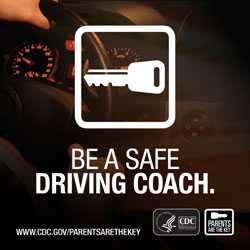Safe Teen Driving

Put proven methods into practice to help teens become safer drivers.
Learning to drive is often considered a rite of passage for teenagers. But with the reward of being a new driver comes real risk.
Know the Facts
- Motor vehicle crashes are the leading cause of death for US teens.
- More than 2,300 teens (ages 16‒19) lost their lives in car crashes in 2015—that’s six teens every day.
- Per mile driven, teen drivers ages 16 to 19 are nearly three times more likely than drivers aged 20 and older to be in a fatal crash.
- Driver inexperience is a main cause of fatal crashes for teen drivers.
- The number one threat to teens’ safety is driving or riding in a car with a teen driver.
- Fortunately, teen motor vehicle crashes are preventable.

Always buckle up, it’s the simplest way to prevent car crash deaths.
Parents Are the Key to Save Teen Drivers
CDC’s “Parents Are the Key” campaign helps inform parents about the key role they can—and should—play in protecting their teen drivers. “Parents Are the Key” campaign materials can be used to help parents learn about the most dangerous driving situations for their young driver and how to avoid them. All of the campaign materials—including a parent-teen driving agreement [465 KB]—are available free of charge at Parents Are the Key to Safe Teen Drivers.
CDC made these resources available to provide parents, pediatricians, policymakers, and others with proven information about how to help teen drivers live to their full potential.
Proven Strategies to Prevent Motor Vehicle Injuries among Teen Drivers
Comprehensive graduated driver licensing (GDL) systems help new drivers gain experience under lower-risk conditions by granting driving privileges in stages. Research shows that more comprehensive GDL systems prevent more crashes and deaths than less comprehensive GDL systems. Components of comprehensive GDL systems include:
- A minimum age of 16 years for learner’s permits.
- A mandatory holding period of at least 12 months for learner’s permits.
- Nighttime driving restrictions between 10:00 pm and 5:00 am (or longer) for intermediate or provisional license holders.
- A limit of zero or one young passenger who can ride with intermediate or provisional license holders without adult supervision.
- A minimum age of 18 years for unrestricted licensure.
Primary enforcement seat belt laws that cover occupants in all seating positions is another effective strategy to prevent or reduce crash-related injuries and deaths involving teen drivers.
See how effective your state is in preventing or reducing crash-related injuries and deaths among teens.
CDC’s GDL Planning Guide [3.32 MB] is designed to assist states to assess, develop, and implement actionable plans to strengthen graduated driver licensing practices.

Parents can make a difference. Discuss your rules of the road with your teen and create a Parent-Teen Driving Agreement that puts these rules in writing to set clear expectations and limits.
CDC’s Injury Center is Committed to Preventing Teen Crashes and Related Deaths and Injuries
A new CDC study called Characteristics of Single Vehicle Crashes with a Teen Driver in South Carolina, 2005-2008 showed that when teen drivers crashed while transporting teen passengers, the passengers were >5 times more likely to all be restrained if the teen driver was restrained. Crashes were twice as likely to result in serious injury when teen passengers were present than when the teen driver was alone. The report also highlights the need for surveillance systems that link crash data with health outcome data to more fully understand the circumstances and consequences of teen driver nonfatal crashes and to evaluate the effectiveness of strategies to improve teen driver safety.
CDC’s study Parental Perceptions of Teen Driving: Restrictions, Worry and Influence reveals that most parents report having rules and restrictions for their teen drivers, but only a small percentage formalize the rules and restrictions in a written parent-teen driving agreement. Parents worry less about their teen driver’s safety during the newly licensed phase, when crash risk is high as compared to the learning phase. Implementing parent-teen driving agreements and updating existing agreements can assist families in keeping restrictions and expectations clear and ongoing as teens gain experience driving independently.
According to the Youth Risk Behavior Surveillance – United States, 2015, 42 percent of high school students who drive report texting or emailing while driving during the past 30 days.
Because one out of every three teen deaths is the result of a motor vehicle crash, further reductions in teen crashes and related injuries are essential. CDC’s “Parents Are the Key” campaign and Prevention Status Reports can help parents, policymakers, and others take steps to save young lives.
Graduated Driver Licensing Night Driving Restrictions and Fatal Night Crashes — 40 States, 2009–2014 highlights that strategies to further reduce overall fatal crashes among newly licensed teen drivers should address night-time crashes. Nearly one-third of drivers ages 16‒17 involved in fatal crashes nationwide crashed during the nighttime hours of 9:00 pm to 5:59 am. Of drivers involved in night crashes, 57 percent crashed before midnight.
Graduated Driver Licensing (GDL) night driving restrictions have been shown to reduce crashes among newly licensed teens, with greater reductions associated with those starting at 9 pm or 10 pm. However, in 25 states, the night driving restriction begins at midnight or later. States play a key role in keeping beginner teen drivers safe and could consider updating their GDL night driving restriction coverage to include earlier nighttime hours.
More Information
- Centers for Disease Control and Prevention (CDC). 1991-2015 High School Youth Risk Behavior Survey
- Driving Among High School Students – United States, 2013
- Parents Are the Key: Campaign for Safe Teen Driving
- Prevention Status Reports
- Facts and Resources about Teen Drivers
- CDC Podcast: “Teens Take the Wheel”
- CDC Podcast: “Driving After Dark”
- CDC’s Graduated Driver Licensing System Planning Guide [3.32 MB]
- Traffic Safety Marketing: National Teen Driver Safety Week
- Page last reviewed: October 16, 2017
- Page last updated: October 16, 2017
- Content source:
- National Center for Injury Prevention and Control
- Page maintained by: Office of the Associate Director for Communication, Digital Media Branch, Division of Public Affairs




 ShareCompartir
ShareCompartir